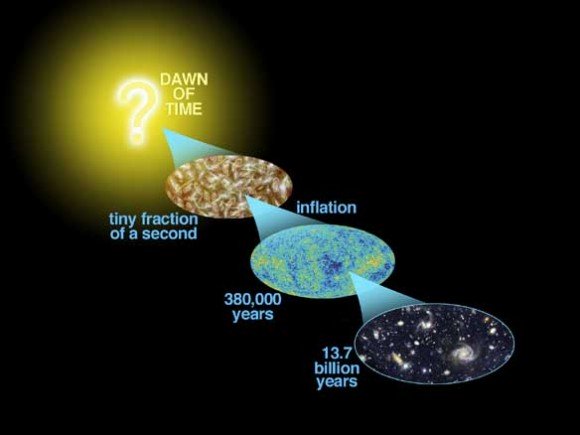C reative
Particle
Higgs
CPH Theory is based on Generalized light velocity from energy into mass.
CPH Theory in Journals
|
Our Early Universe: Inflation, or Something Totally Wacky?
|
|
Our Early Universe: Inflation, or Something Totally Wacky?
A schematic look at the universe - where it came from and where it is now. Credit: NASA.
Astronomers generally accept the theory that our universe looks the way it does because of cosmic inflation — rapid expansion in the moments after its birth. This explains the expanse and apparent flat shape of the universe observed through instruments like NASA’s Wilkinson Microwave Anisotropy Probe. But inflation isn’t the only model that explains the early universe. There are others, and they get wacky. Three physicists from the University at Buffalo — Ghazal Geshnizjani, Will Kinney and Azadeh Moradinezhad Dizgah — set out to investigate other cosmic models. Their study titled “General Conditions for Scale-Invariant Perturbations in an Expanding Universe” appeared in November in the online Journal of Cosmology and Astroparticle Physics (not to be confused with theJournal of Cosmology) and contained some interesting results.
This picture of the infant universe from NASA's Wilkinson Microwave Anisotropy Probe (WMAP) reveals 13 billion+ year old temperature fluctuations that correspond to the seeds that grew to become the galaxies. Credit: NASA Goddard Space Flight Center.
They stuck with the basics — that the theory of gravity is correct and that the early universe did rapidly expand. With these two constraints, the team found that only three models explain the early universe and the distribution of matter we observe today. But these models require very strange physics. According to their calculations, the early universe required an accelerated cosmic expansion (inflation), a speed of sound faster than the speed of light, or extremely high cosmic energy to end up with our current universe. The third model actually demands such high energy that scientists would need to invoke a theory of quantum gravity like string theory to explain the extra dimensions of space-time that would pop up. The takeaway message? Inflation turns out to be the only way to explain the universe within the context of standard physics, said Kinney. He allows that someone might come up with exotic physics to explain or create other models, like a speed of sound faster than that of light, but suspects people are more comfortable working with models that fit within commonly accepted laws of particle physics. The difficulty of explaining other models, said Kinney, “puts the idea of inflation on a much stronger footing, because the available alternatives have problems, or weirdnesses, with them.” Cosmic inflation incorporates quantum field theory to explain the distribution of matter in the universe. Under normal circumstances, particles of matter and antimatter can pop into existence suddenly before colliding and annihilating each other instantly. These pairs flew apart so rapidly after the universe’s birth that they didn’t have a chance to recombine. The same theory applies to gravitons and antigravitons, which form gravity waves. These particles of matter are the basis of all structure in the universe today. Tiny fluctuations cause matter to collapse and form stars, planes, and galaxies. But the hunt for other viable models continues. Kinney for one isn’t finished exploring other theories, including those that rely on superluminal sound speeds. There may yet be some major changes to our understanding of the cosmos.
Source: The University of Buffalo
1 2 3 4 5 6 7 8 9 10 Newest articles
|
|
Sub quantum space and interactions from photon to fermions and bosons |
Interesting articles
Since 1962 I doubted on Newton's laws. I did not accept the infinitive speed and I found un-vivid the laws of gravity and time.
I learned the Einstein's Relativity, thus I found some answers for my questions. But, I had another doubt of Infinitive Mass-Energy. And I wanted to know why light has stable speed?


